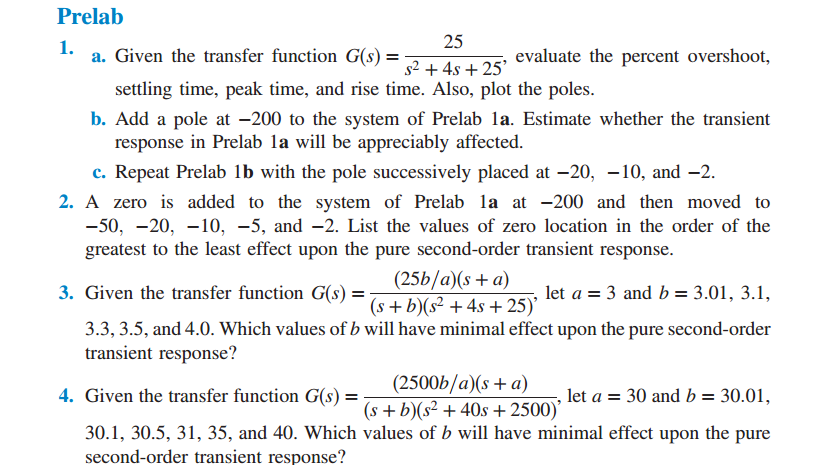Answered step by step
Verified Expert Solution
Question
1 Approved Answer
Prelab 1. 25 s + 4s +25 settling time, peak time, and rise time. Also, plot the poles. a. Given the transfer function G(s)


Prelab 1. 25 s + 4s +25 settling time, peak time, and rise time. Also, plot the poles. a. Given the transfer function G(s) = b. Add a pole at -200 to the system of Prelab 1a. Estimate whether the transient response in Prelab la will be appreciably affected. c. Repeat Prelab 1b with the pole successively placed at -20, -10, and -2. 2. A zero is added to the system of Prelab la at -200 and then moved to -50, -20, -10, 5, and -2. List the values of zero location in the order of the greatest to the least effect upon the pure second-order transient response. evaluate the percent overshoot, (25b/a)(s + a) (s + b)(s + 4s+25)' let a = 3 and b = 3.01, 3.1, 3.3, 3.5, and 4.0. Which values of b will have minimal effect upon the pure second-order transient response? 3. Given the transfer function G(s) = 4. Given the transfer function G(s) = (2500b/a)(s + a) (s + b)(s + 40s + 2500)' , let a 30 and b = 30.01, 30.1, 30.5, 31, 35, and 40. Which values of b will have minimal effect upon the pure second-order transient response? 1. Using Simulink, add a pole to the second-order system of Prelab la and plot the step responses of the system when the higher-order pole is nonexistent, at 200, 20, 10,
Step by Step Solution
★★★★★
3.49 Rating (166 Votes )
There are 3 Steps involved in it
Step: 1

Get Instant Access to Expert-Tailored Solutions
See step-by-step solutions with expert insights and AI powered tools for academic success
Step: 2

Step: 3

Ace Your Homework with AI
Get the answers you need in no time with our AI-driven, step-by-step assistance
Get Started


